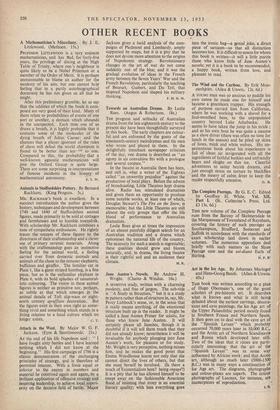Animals in Staffordshire Pottery. By Bernard Rackham. (King Penguin. 5s.)
MR. RACKHAM'S book is excellent. In a succinct introduction the author gives the history, techniques and development between 1740 and 1840 of Staffordshire animal figures, made primarily to be sold at cottages and farmhouses and to humble townsfolk. With scholarship Mr. Rackham combines a tone of sympathetic enthusiasm. He rightly traces the success of these figures to the directness of their craftsmanship and a clever use of primary ceramic materials. Along with the craftsmanship goes an instinctive feeling for the animal world, a feeling carried over from domestic animals and animals of the chase to the remoter elephants, buffaloes and giraffes. The familiar cat in Plate 1, like a giant striped humbug, is a fine piece, but so is the unfamiliar elephant in Plate 6, with its bold splashes of unnatural- istic colouring. The vision in these animal figures is neither as primitive nor, perhaps, as subtle as that which emerges in the animal details of Toft slip-ware or eight- eenth century sgraffiato decoration. But the figures exist in their own right as some- thing vivid and something which stands in a living relation to a local culture which no
































 Previous page
Previous page